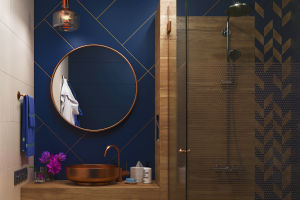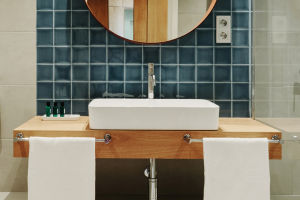
Traditional design can sometimes feel old-fashioned and unexciting, while modern design can lean too much towards a sleek and minimalist appearance.
Transitional design, on the other hand, combines elements from both aesthetics to create a timeless yet fresh atmosphere. Think of it as a fusion of the best aspects of both worlds.
At its core, transitional style is a harmonious blend of various elements from traditional and modern design. It incorporates curves and straight lines, creating an open and refined ambiance with a texture that doesn't lead to clutter.
In transitional interiors, you might encounter classic deep sofas paired with contemporary graphic pillows, Victorian-style chandeliers hanging above, and off-white linen curtains framing windows, adding both shine and ornamentation.
However, creating a well-designed transitional space goes beyond merely selecting elements from both styles.
Transitional style is the ideal solution for those who find it challenging to define their style as strictly classic or contemporary.
It seamlessly bridges the gap between these two aesthetics, resulting in a sophisticated yet casual and approachable interior. Here are some easy ways to recognize Transitional Style:
1. Color schemes are predominantly neutral, with darker colors used as accents.
2. Minimalism is embraced without sacrificing character or personality.
3. Focus on comfort, particularly with larger sofas or beds.
4. Use large patterned textiles that do not overwhelm the space.
5. Achieve balance by layering metal and glass with natural materials like wood and rattan.
6. Embrace symmetry, clean lines, and polished finishes.
The transitional style is a relatively recent addition to the design world, with its roots tracing back to the 1950s and the subsequent era of postmodernism.
The desire for more comfortable pieces, contrasting with the stark and streamlined aspects of modernism and postmodernism, led to transitional design's emergence. It embodies a balance between comfort and elegance.
Transitional design is an evolving style, often incorporating contemporary elements. It is a modern style that adapts to current trends while seamlessly blending with classic design elements. The style remains focused on the art of balancing comfort with sophistication.
To achieve the transitional look in your home, consider starting with a piece you already own.
This combination of traditional and contemporary styles defines transitional design, making it a modern style. While today's contemporary and transitional styles may seem similar, they can evolve differently in the future.
Modern design complements transitional style by balancing classic elements and bringing the space into the 21st century. Minimalism remains a constant, downplaying ornate embellishments seen in traditional design with fewer decorative accents and less formal finishes.
To infuse transitional details into your home, consider the following:
- Paint the walls in pastel shades and select upholstery in the same color palette.
- Invest in a standout piece, like modern architectural lighting or an antique coffee table.
- Keep accessories to a minimum for a streamlined, minimalist look.
- Incorporate substantial club chairs or sofas with clean lines.
- Avoid bold patterns and reduce printed designs.
- Integrate premium textures such as wood and glass into your design.
Transitional design offers a bridge between the classic and contemporary, allowing you to create a comfortable, yet stylish living space that stands the test of time.


